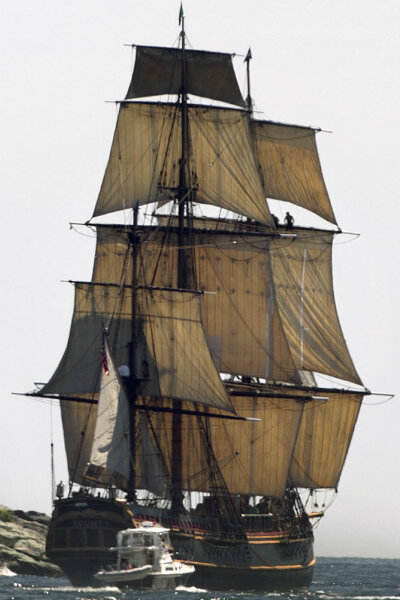Coast Guard concludes HMS Bounty captain went down with ship
While questions will remain about Bounty Capt. Robin Walbridge’s decision to brave Cape Hatteras, N.C., during a hurricane, his ultimate legacy, his family says, will be one that goes back to the origins of global seafaring: his final act of putting his crew and ship above himself.
After 90 hours of searching some 12,000 square miles of open ocean, the US Coast Guard on Friday suspended the search for Mr. Walbridge, who had captained the 180-foot three-master for 17 years. The boat was a near-exact replica of the 18th-century “square rigger” that became the scene of a mutiny that inspired half a dozen Hollywood movies.
In the end, the Coast Guard concluded that the Bounty’s loss to hurricane Sandy took two lives. Claudene Christian, who joined the Bounty in May and claimed an ancestral link to Bounty mutineer Fletcher Christian, died after being pulled out of the waters on Monday.
But as the Coast Guard made its condolences and began an investigation into the sinking, his family hailed Walbridge for being the consummate captain in his efforts to make sure that the rest of the crew survived after it became clear that the Bounty was going to sink.
"He always looked after his crew first," his sister, Lucille Jansen, told Reuters. "That's the last memory we'll have of him because he did exactly what a captain should do. He made sure the crew was safe."
Born in Vermont, Walbridge grew up in Florida, where he turned a teenage love of sailing into a career, first as a houseboat mechanic on the Suwanee River, then captaining the Governor Stone, Vision Quest, and Bill of Rights as he earned his 50-, 100-, and 500-ton captain’s licenses.
His work on tall ships began on the Tall Ship "HMS" Rose, and he moved on to the Bounty in 1995. According to his biography, the Bounty would have sunk at the docks in Fall River, Mass., without Walbridge’s efforts to raise renovation funds. He also served as guest captain on the USS Constitution when it made its inaugural sail in 1997, after the ship had sat dockside for 116 years.
Walbridge’s hobbies included building experimental kayaks, flying, photography, and chess. The Bounty, built in 1960, was “his passion,” his wife, Claudia McCann, told the Associated Press.
The Coast Guard’s investigation will try to find the cause of the tragedy, as well as whether any mechanical problems or crew misconduct led to the Bounty’s end.
The 14 surviving crew members have collectively decided to not discuss the Bounty’s demise with the media, but fellow tall ship captains and maritime experts have questioned Walbridge’s decision to set sail for Florida last week as hurricane Sandy took aim at the US mainland.
“The thing that’s striking is why Walbridge put himself in that position,” Sal Mercogliano, a maritime history professor at Campbell University in Buies Creek, N.C., told the Monitor this week. “It’s hard for a lot of people to fathom.”
Walbridge, who was known to claiming that a ship is safer at sea than in port during a storm, intended to skirt around the hurricane. But late Sunday, the ship apparently lost power and began taking on water as it tried to make its way around Cape Hatteras. On Monday, the Coast Guard undertook a daring rescue operation that plucked the Bounty's survivors out of 20-foot waves.








